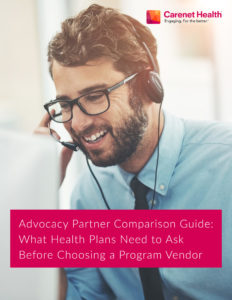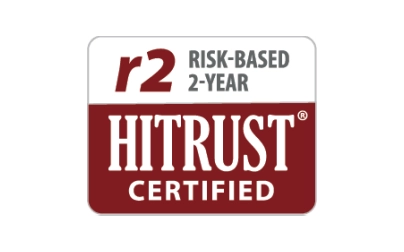Consumer health advocacy programs—also known as healthcare navigation assistance and concierge-level member support—are becoming increasingly valuable to health plans, risk-based providers and employer groups who want to help their members and employees get the most out of their health and wellness benefits.
That’s because giving healthcare consumers what they need to live their healthiest lives is good for everyone—employees, employers, payers and providers alike. As the name suggests, health advocacy programs are designed to advocate on behalf of patients, help them solve problems and empower them to make more informed healthcare decisions. Programs can include a wide range of services, everything from health plan member onboarding to health coaching to care coordination to follow-up support.
For many health plans, outsourcing their advocacy program to an external partner is a cost-effective way to provide this personalized health plan customer service. When payers use an external partner, their members get a dedicated team to help them understand and navigate the complex healthcare ecosystem, and payers can leverage advanced technology and the ability to scale a program to meet changing demand.
Knowing the kinds of questions a health advocate can answer is a good place to start when choosing a health advocacy services partner. Health plans should also have questions that drill down on the partner program’s specific features for member advocacy—asking potential vendors everything from whether or not a solution can be white-labeled for a seamless plan or employer experience to how (or if) the program can be customized.
With studies indicating about 50% of consumers won’t move forward with care or wellness actions once they hit a roadblock, details like these become critical to offering a successful program. What’s more, employers are turning to advocacy programs to help them manage costs, most notably by offering employees advocacy support for getting second-opinions, managing chronic conditions and resolving disputed claims and surprise bills, according to the Society for Human Resource Management.

To help you find the best health concierge partner for your health plan (and it’s okay if that right-fit partner is not us), we’ve put together a list of questions we recommend you consider asking potential vendors in our Advocacy Partner Comparison Guide. We’ve included the first three questions below. To see the full list and gain other tips and insights, please download the complete guide.
QUESTION 1
What will the navigation support look like to members?
As healthcare consumers, members will expect the same kind of convenience they’re already getting in other areas of their lives. It’s important to find out what combination of digital and live-support engagement services are offered and how easily members can access them.
- Is support available 24 hours a day/seven days a week, or only during typical business hours?
- Will members always be able to speak with a live person when they call?
- Is there one point of access for finding advocate support?
- Can the advocacy program be integrated with other employee benefits and programs?
- Will members work with the same advocate throughout one problem or need?
Look for a partner that understands the full range of member experience touchpoints in a consumer’s typical healthcare journey, from gaining awareness of plan benefits and participating in wellness programs to needing medication adherence support. A high level of knowledge and integration across programs will likely deliver the best member experience.
QUESTION 2
Can the advocacy program be customized?
After assessing your health plan’s resources and both members’ and employers’ needs, you probably have a good idea where you have advocacy and service gaps.
Consider factors like:
- What kinds of questions do you want advocates to be able to answer for members?
- Are you looking to add clinical support for members to an existing program you already have in place?
- Do you have a program for chronic condition management but need something to help members find support after a difficult diagnosis or a surprise medical bill?
Seek out a partner that is flexible enough to be able to customize your program, so you purchase only the services your plan needs.
QUESTION 3
Who can utilize the advocacy program’s services?
With so many employees today having to manage care for aging parents, this can be a not-so-surprising sticking point. It’s important to find out if employees can use an advocate, for instance, to help with things like arranging Meals on Wheels or transportation to physician appointments for family members.
If services are available only to members and enrolled dependents, a vendor’s program may be too limited for your employer group needs.
More about the connection between healthcare consumer-centricity and navigation services
As the industry continues to shift toward consumer-driven, value-oriented healthcare, health plans are rethinking how they do business with both employer groups and consumers.
To remain competitive, progressive plans are adopting a consumer-first mindset that elevates the overall healthcare experience while curbing costs for all stakeholders. Advocacy and navigation member services will be an important part of that shift.
Don’t stop here
You can find more questions you should ask and what features to consider when choosing an advocacy partner in our Advocacy Partner Comparison Guide: What Health Plans Need to Ask Before Choosing a Program Vendor. The guide includes a useful worksheet for comparing those who respond to your RFP.
PLUS: Be sure to browse our other guides and ebooks on our Resource Center.


